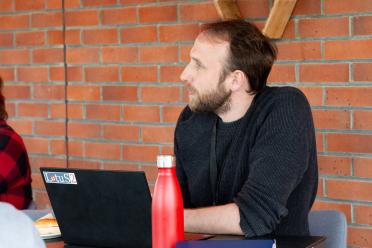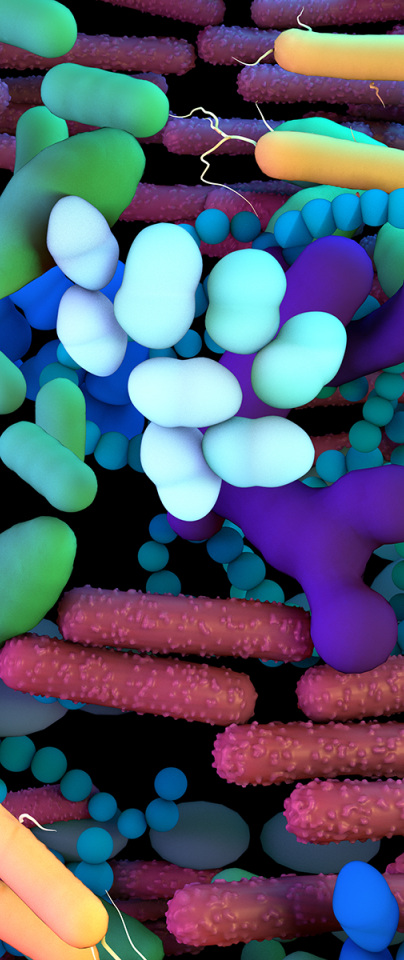Microbiome sharing… is microbiome caring
The global impact of a Quadram Institute and Earlham Institute researcher has been recognised with their inclusion in this year’s Clarivate Highly Cited Researchers List.
Dr Falk Hildebrand has been a Group Leader, working across the two UKRI BBSRC institutes based on the Norwich Research Park, since early 2019.
The annual list is based on the Web of Science citation index and compiled by the Institute for Scientific Information at Clarivate. It recognises the most influential researchers on a global scale by naming those ranking in the top 1 per cent by citations for their field over the last 10 years.

The Earlham Institute (left) and Quadram Institute (right) are co-located next to each other as partners on the Norwich Research Park. Image: ©AngliaInnovationPartnership
Dr Hildebrand’s group develops metagenomic tools to track bacterial strains at high resolutions, predict their genomic capabilities and explore associations to diseases.
“I knew about this list because several researchers I hold in high esteem are on it,” he says. “I was pleasantly surprised to be considered.
“It’s nice to feel that my work is acknowledged - but I am also aware that this wouldn't have been possible without collaboration.
“For example, I think my work with Peer Bork in Heidelberg and Jeroen Raes in Leuven, and our collaborations within the METAHIT consortium were an important part of being considered in this list, with research such as reconstructing genomes from metagenomes and discovering for the first time that medical drugs can influence the gut microbiome.
“A large part can also be attributed to soil work with Mohammad Bahram in Sweden, and Parkinson's Disease related work with Janis Bedarf in Bonn. We had some highly cited works that still have a lasting impact on the field.”

Group Leader, Dr Falk Hildebrand
Falk describes himself as “constantly fascinated” by bacteria and the microbiome.
“The evolution of bacteria alongside humans is really interesting,” he says.
“We’ve lived with bacteria for millennia. We’ve learnt to use them to make nutrients in food more accessible or last longer - we ferment bread or beer, turn milk into cheese or yoghurt.
“But these processes are not just external. Bacteria perform the same role inside us, in our gut. They live with us and help us break down complex foods.”
The human gut is thought to harbour anywhere from 200 to 800 different bacterial species and this community influences the body in ways only now being discovered. It aids digestion, protects against infections, and shapes our immune system.
“Remarkably, gut bacteria are able to communicate directly with the brain through the vagus nerve,” says Dr Hildebrand.
“This connection is known as the microbiota-gut-brain axis - a two-way connection between gut and mind. The microbiome does not only influence physical health but has a huge impact on our mental health too.”
One of his current projects is the PEARL-Age study, which explores how we pass microbes between us by investigating how microbiomes are shared within families and passed down through generations. It is recording microbial similarities and differences among parents, children, and siblings.
“My lab has found some very good data on bacterial exchange between people living in the same household,” he says.
“Families do actively exchange microbes - usually around 30 per cent of their gut bacteria. But the longer two or more people stay in the same household, the more their microbiomes become similar.
“After a long life together, there are literally more microbial similarities you share with your chosen partner than with anyone else on this planet.”
But microbes are not just exchanged between human beings. Falk says we also swap microbes with our furry friends.
“Pet owners and their pets are exchanging quite a few microbes,” he explains.


My lab has found some very good data on bacteria exchange between people living in the same household. Families do actively exchange microbes - usually around 30 per cent of their gut bacteria. But the longer two or more people stay in the same household, the more their microbiomes become similar.

Dr Hildebrand is particularly interested in developing specialised algorithms to help answer complex questions on large biological datasets, the metagenomic view of whole microbial ecosystems, and environmental metagenomics.
He began his career at the University of Constance in Germany and the University of Sussex in the UK, using changes in bacterial genomes to understand bacterial evolution and track outbreaks of pathogens.
He took his PhD at the University of Brussels, specialising in bacterial associations with complex diseases such as inflammatory bowel disease, obesity, and diabetes.
He was a postdoc at EMBL Heidelberg in Germany before coming to the Norwich Research Park, working on the association between the human microbiome and complex diseases such as diabetes and Parkinson’s.
At the Earlham Institute he is contributing to two strategic programmes of research - Decoding Biodiversity and Cellular Genomics - linking fine-scale microbial diversity to ecosystem functions and cell expression heterogeneity impact on environmental response.
Falk’s role as a Research Group Leader in the Food, Microbiome and Health programme at the Quadram Institute allows him to bring together expertise and infrastructure into his research. He says working across both institutes has a number of benefits.
“I am able to talk to so many talented and knowledgeable individuals from really diverse backgrounds,” he says.
“This is hugely beneficial to getting new viewpoints on my research - and is quite fun usually, as well. Each institute holds different technologies as well which is certainly helpful.”
Beyond publications, Dr Hildebrand and his group have also delivered wider impact through developing tools such as LotuS2, running courses with the Advanced Scientific Training team, supervising PhD students, and delivering public engagement activities.